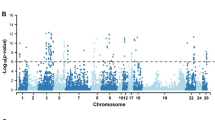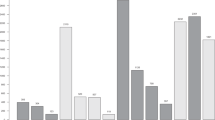Abstract
The autosomal Booroola fecundity gene (FecB) mutation in sheep increases ovulation rate and litter size, with associated effects on ovarian physiology and hormone profiles. Analysis of segregation in twelve families (379 female progeny) identified linkage between the mutation, two microsatellite markers (OarAE101 and OarHH55, Zmax >9.0) and epidermal growth factor (EGF) from human chromosome 4q25 (Zmax >3.0). The marker OarAE101 was linked to secreted phosphoprotein 1 (SPP1, which maps to chromosome 4q21–23 in man) in the test pedigrees and independent families (Zmax >9.7). The identification of linkage between the FecB mutation and markers from human chromosome 4q is an important step towards further understanding the control of ovulation rates in mammals.
This is a preview of subscription content, access via your institution
Access options
Subscribe to this journal
Receive 12 print issues and online access
$209.00 per year
only $17.42 per issue
Buy this article
- Purchase on Springer Link
- Instant access to full article PDF
Prices may be subject to local taxes which are calculated during checkout
Similar content being viewed by others
References
Bindon, B.M. & Piper, L.R. The reproductive biology of prolific sheep breeds. Oxford rev. Reprod. Biol. 8, 414–451 (1986).
Piper, L.R. & Bindon, B.M. The Booroola Merino and the performance of medium non-Peppin crosses at Armidale. In The Booroola Merino (eds Piper, LR. et al.) 9–20 (CSIRO, Melbourne, 1982).
Davis, G.H., Montgomery, G.W., Allison, A.J., Kelly, R.W. & Bray, A.R. Segregation of a major gene influencing fecundity in progeny of Booroola sheep. N.Z. J. agric. Res. 25, 525–529 (1982).
Davis, G.H. & Kelly, R.W. Segregation of a major gene influencing ovulation rate in progeny of Booroola sheep in commercial and research flocks. Proc. N.Z. Soc. anim. Prod. 43, 197–199 (1983).
COGNOSAG. Standardised Genetic Nomenclature for Sheep and Goats 49–52 (Lavoisier, Paris, 1989).
Piper, L.R., Bindon, B.M. & Davis, G.H. The single gene inheritance of the high litter size of the Booroola Merino. in Genetics of Reproduction in Sheep (eds Land, R.B. et al.) 115–125 (Butterworths, London, 1985).
Montgomery, G.W., McNatty, K.P. & Davis, G.H. Physiology and molecular genetics of mutations that increase ovulation rate in sheep. Endocr. Rev. 13, 309–328 (1992).
McNatty, K.P. & Henderson, K.M. Gonadotrophins, fecundity genes and ovarian follicular function. J. steroid Biochem. 27, 365–373 (1987).
Montgomery, G.W., Sise, J.A., Greenwood, P.J. & Fleming, J.S. Booroola F gene mutation in sheep is not located close to the FSH-β gene. J. molec. Endo. 5, 167–173 (1990).
Crawford, A.M., Buchanan, F.C. & Swarbrick, P.A. The use of dinucleotide repeats or microsatellites as genetic markers in domestic animals. Proc. N.Z. Soc. anim. Prod. 51, 79–83 (1991).
Montgomery, G.W., Tate, M., Crawford, A.M. & Hill, D.F. The application of genetic linkage in the search for the Booroola gene. Proc. Aust. Assoc. anim. Breed. Genet. 8, 191–194 (1990).
Mulsant, P. et al. Genetical and biochemical approaches to identify and isolate the Booroola F gene. in Major genes for reproduction in sheep (eds Elsen, J.M. et al.) 259–268 (INRA, Paris,1991
Montgomery, G.W. et al. Genetic linkage approaches to the identification of the Booroola F gene. in Major gens for reproduction in sheep (eds Elsen, J.M. et al.) 269–274 (INRA, Paris, 1991).
Tate, M.L., Manly, H.C., Dodds, K.G. & Montgomery, G.W. A genetic linkage analysis between protein polymorphisms and the FecB major gene in sheep. Anim. Genet. 23, 417–424 (1992).
Dodds, K.G., Montgomery, G.W. & Tate, M.L. Testing for linkage between a marker locus and a major gene locus in half sib families. J. Hered. 84, 43–48 (1993).
Montgomery, G.W., Sise, J.A., Penty, J.M., Tou, H.M. & Hill, D.F. Sheep linkage mapping: restriction fragment length polymorphism detection with heterologous cDNA probes. Anim. Genet. 23, 411–416 (1992).
Montgomery, G.W., Penty, J.M., Sise, J.A. & Tou, H.M. Genes for the α and β chains of FSH are excluded as sites for the Booroola FecB mutation in sheep. J. reprod. Fert. 95, 895–901 (1992).
Kerr, J.M., Fisher, L.W., Termine, J.D. & Young, M.F. The cDNA cloning and RNA distribution of bovine osteopontin. Gene 108, 237–243 (1991).
Murray, J.C., DeHaven, C.R. & Bell, G.I. RFLPs for epidermal growth factor (EGF), a single copy sequence at 4q25–4q27. Nucl. Acids Res. 14, 5117 (1986).
Goldberger, G., Bruns, G.A.P., Rits, M., Edge, M.D. & Kwiatkowski, D.J. Human complement factor I: Analysis of cDNA-derived primary structure and assignment of its gene to chromosome 4. J. biol. Chem. 262, 10065–10071 (1987).
Crawford, A.M., Buchanan, F.C. & Swarbrick, P.A. Ovine dinucleotide repeat polymorphism at the MAF18 locus. Anim. Genet. 21, 433–434 (1990).
Swarbrick, P.A., Buchanan, F.C. & Crawford, A.M. Ovine dinucleotide repeat polymorphism at the MAF23 locus. Anim. Genet. 22, 191 (1990).
Buchanan, F.C., Swarbrick, P.A. & Crawford, A.M. Ovine dinucleotide repeat polymorphism at the MAF4 locus. Anim. Genet. 22, 373–374 (1991).
Threadgill, D.W. & Womack, J.E. Genomic analysis of the major bovine milk protein genes. Nucl. Acids Res. 18, 6935–6942 (1990).
Ansari, H.A. et al. Resolving ambiguities in the sheep karyotype: a molecular cytogenetic approach. Proc. 10th Europ. Colloq. cytogenet. domestic anim. (in the press).
Charbot, B., Stephenson, D.A., Chapman, V.M., Besmer, P. & Bernstein, A. The proto-oncogene c–kit encoding a transmembrane tyrosine kinase receptor maps to the mouse W locus. Nature 335, 88–89 (1988).
Geissler, E.N., Ryan, M.A. & Housman, D.E. The dominant white-spotting (W) locus of the mouse encodes the c–kit proto-oncogene. Cell 55, 185–192 (1988).
Nocka, K. et al. Expression of c–kit gene products in known cellular targets of W mutations in normal and Wmutant mice — Evidence for an impaired c–kit kinase in mutant mice. Genes Dev. 3, 816–826 (1989).
Russell, E.S. Hereditary anemias of the mouse. Adv. Genet. 20, 357–459 (1979).
Silvers, K. The Coat Colours of Mice (Springer-Verlag, New York, 1979).
Bendell, J.J. & Dorrington, J.H. Epidermal growth factor influences growth and differentiation of rat granulosa cells. Endocrinology 127, 533–540 (1990).
Lord, E.A. & Hill, D.F. Booroola gene carrries. Proc. NZ Soc. anim. Prod. 51, 91–93 (1991).
Fleming, J.S. et al. Expression of the genes for α inhibin, βA inhibin and follistatin in the ovaries of Booroola ewes which were homozygotes or non-carriers of the fecundity gene FeeB. J. molec. Endo. 8, 265–273 (1992).
Webb, R. & Gauld, I.K. Folliculogenesis in sheep: control of ovulation rate. in Genetics of Reproduction in Sheep (eds Land, R. B. et al.) 261–274 (Butterworths, London, 1985).
Henderson, K.M. & McNatty, K.P. Factors influencing ovulation rate in sheep. Proc. Asian-Australasian Assoc. anim. Prod. 4, 130–138 (1987).
McNatty, K.P. et al. FSH influences follicle viability, oestradiol biosynthesis and ovulation rate in Romney ewes. J. reprod. Fert. 75, 121–131 (1985).
Henderson, K.M., Savage, L.C., Ellen, R.L., Ball, K. & McNatty, K.P. Consequences of increasing or decreasing plasma FSH concentrations during the preovulatory period in Romney ewes. J. reprod. Fert. 84, 187–196 (1988).
Parisi, P., Gatti, M., Prinzi, G. & Caperna, G. Familial incidence of twinning. Nature 304, 626–628 (1983).
Philippe, P. Genetic epidemiology of twinning: A population-based study. Am. J. med. Gen. 20, 97–105 (1985).
Martin, N.G. et al. Pituitary-ovarian function in mothers who have had two sets of dizygotic twins. Fertil. Steril. 41, 878–880 (1984).
Wyshak, G. & White, C. Genealogical study of human twinning. Am. J. public Health 55, 1586–1593 (1965).
Bradford, G.E., Inounou, I., Iniguez, L.C., Tiesnamurti, B. & Thomas, D.L. The prolificacy gene of Javanese sheep. in Major genes for reproduction in sheep (eds Elsen, J. M. et al.) 67–73 (INRA, Paris, 1991).
Davis, G.H., McEwan, J.C., Fennessy, P.F., Dodds, K.G. & Farquhar, P.A. Evidence for the presence of a major gene influencing ovulation rate on the X chromosome of sheep. Biol. Reprod. 44, 620–624 (1991).
Eythorsdottir, E., Adalsteinsson, S., Jonmundsson, J.V. & Hanrahan, J.P. Research work on the Icelandic Thoka gene. in Major genes for reproduction in sheep> (eds Elsen, J. M. et al.) 75–84 (INRA, Paris, 1991).
Hanrahan, J.P. Evidence for single gene effects on ovulation rate in the Cambridge and Belclare breeds. in Major genes for reproduction in sheep (eds Elsen, J. M. et al.) 93–102 (INRA, Paris, 1991).
Martyniuk, E. & Radomska, M.J. A single gene for prolificacy in Olkuska sheep. in Major genes for reproduction in sheep (eds Elsen, J.M.et al.) 85–92 (INRA, Paris, 1991).
Montgomery, G.W. & Hawker, H. Seasonal reproduction in ewes selected on seasonal changes in wool production. J. reprod. Fert. 79, 207–213 (1987).
Montgomery, G.W. & Sise, J.A. Extraction of DNA from sheep white blood cells. NZ. J. agric. Res. 33, 437–441 (1990).
Rigby, D.W.J., Dieckmann, M., Rhodes, C. & Berg, P. Labelling deoxyribonucleic acid to high specific activity in vitro by nick translation with DNA polymerase I. J. molec. Biol. 113, 237–251. (1977).
Brown, W.M., Dziegielewska, K.M., Foreman, R.C. & Saunders, N.R. Nucleotide and deduced amino acid sequence of sheep serum albumin. Nucl. Acids Res. 17, 10495 (1989).
Stewart, A.F., Willis, I.M. & MacKinlay, A.G. Nucleotide sequences of bovine alpha–s1- and kappa-casein cDNAs. Nucl. Acids Res. 12, 3895–3907 (1984).
Kelly, J.D. et al. PDGF stimulates PDGF receptor dimerization and intersubunit trans-phosphorylation. J. biol. Chem. 266, 8987–8992 (1991).
Lange, K., Weeks, D. & Boehnke, M. Programs for pedigree analysis: MENDEL, FISHER and dGENE. Genetic Epidemiol 5, 471–472 (1988).
Author information
Authors and Affiliations
Rights and permissions
About this article
Cite this article
Montgomery, G., Crawford, A., Penty, J. et al. The ovine Booroola fecundity gene (FecB) is linked to markers from a region of human chromosome 4q. Nat Genet 4, 410–414 (1993). https://doi.org/10.1038/ng0893-410
Received:
Accepted:
Issue Date:
DOI: https://doi.org/10.1038/ng0893-410
This article is cited by
-
Comparative DNA methylome analysis of estrus ewes reveals the complex regulatory pathways of sheep fecundity
Reproductive Biology and Endocrinology (2020)
-
Comparative mRNA and miRNA expression in European mouflon (Ovis musimon) and sheep (Ovis aries) provides novel insights into the genetic mechanisms for female reproductive success
Heredity (2019)
-
Complex genetics of female fertility
npj Genomic Medicine (2018)
-
Ovarian proteomic study reveals the possible molecular mechanism for hyperprolificacy of Small Tail Han sheep
Scientific Reports (2016)
-
Genetic variation of ten microsatellite loci in Makui sheep of Iran
Veterinary Research Communications (2010)



